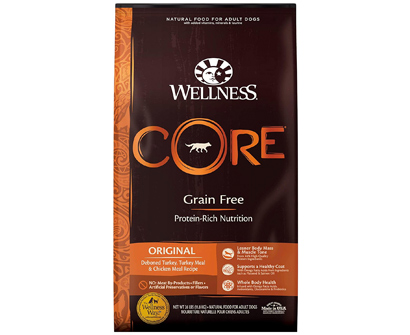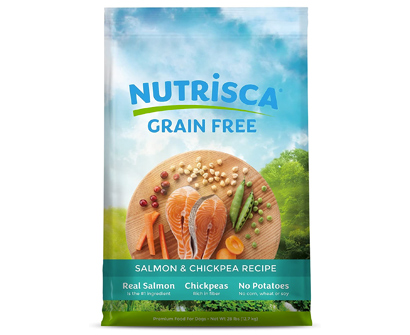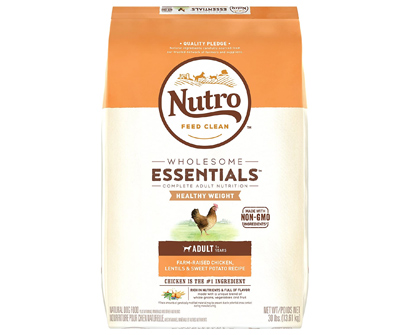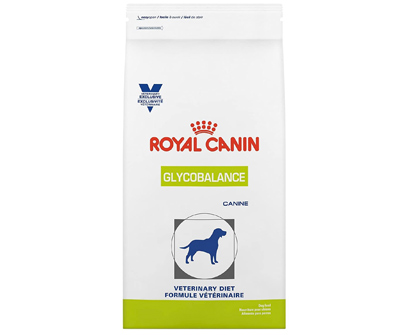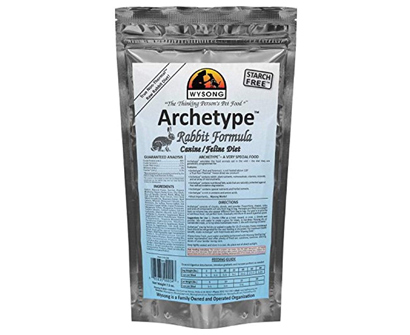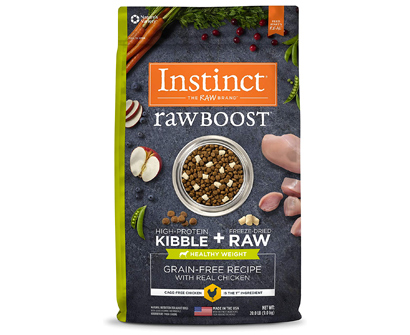The Best Food For Diabetic Dogs in 2022

- The Best Food For Diabetic Dogs
- 1. Wellness Core Free Dry Food for Diabetic Dogs
- 2. Nutrisca Grain Free Salmon Dry Dog Food for Diabetic Dogs
- 3. Nutro Lite Adult Dry Dog Food For Diabetic Dogs
- 4. Royal Canin Glycobalance Dry Dog Food for Diabetic Dogs
- 5. Wysong Archetype Raw Canine Dog Food
- 6. Instinct Raw Boost Healthy Dry Dog Food
Just as human beings can suffer from serious health conditions like diabetes, so too can dogs. And when your dog’s pancreas is not operating at its optimum level, this can end up leading to further health complications. So, as a dog owner, you have both the duty and the desire to help them out in any way that you can. Obviously, what your dog puts into their body can have a great impact on their health, and this is why choosing the best food for diabetic dogs is so important.
Many vets recommend that you monitor your dog’s calorie intake closely, focusing on foods which are high in fiber and protein. You should also look at low glycaemic meals which don’t cause a sharp increase in your dog’s blood glucose levels. So, in this article, we will be taking a closer look at some of the best food to feed your diabetic dog and the qualities which make it so good.
The Best Food For Diabetic Dogs
1. Wellness Core Free Dry Food for Diabetic Dogs
Key Features
100% grain free
Chicken and turkey formula
Contains vegetables and fruits
Infused with essential vitamins and minerals
No artificial preservatives, colors and meat by-products
Suitable for dogs who are over one year old
Our second pick comes from Wellness Core who offer a grain free formula rich in probiotics and antioxidants. Their turkey and chicken recipe made it to our diabetic dog food list for several reasons, and high protein is one of them. Wellness Core believe in providing premium ingredients free from fillers and artificial preservatives. Their dog food is made with a combination of chicken, turkey as well as fruits and vegetables such as sweet potatoes, apples, parsley and broccoli. Essential vitamins and minerals also elevate the nutritional value of this formula. This dry food is suitable for dogs who are over one year old.
2. Nutrisca Grain Free Salmon Dry Dog Food for Diabetic Dogs
Key Features
Real salmon and chickpeas recipe
Grain free balanced nutrition
Does not contain soy, potatoes or wheat
Full of antioxidants, Omega fatty acids and DHA
Free from artificial colorings, hormones and preservatives
Suitable for dogs of all life stages except for large size dogs over 70lbs
The Nutrisca grain-free dry food from Dogswell is formulated to meet the nutritional needs of your pooch and is made with real salmon and flavorsome chickpeas. The wild caught salmon provides an optimal source of essential amino acids and proteins while minerals add more nutritional value to this formula and make it more palatable. Low glycemic peas and chickpeas are also cornerstones of this recipe and are a great source of protein and fiber. Premium fruits and vegetables such as cranberries, carrots and apricots were also added to the mix as well as vitamins A and E. These antioxidant sources help maintain a healthy immune system. This Dogswell product is gluten free and is made without any added hormones, colors or preservatives. Puppies as well as lactating and pregnant dogs can feast on this quality diabetic dog food for lunch and dinner.
3. Nutro Lite Adult Dry Dog Food For Diabetic Dogs
Key Features
Low calorie recipe made with farm raised chicken
High quality protein formula for weight loss management
Contains blend of minerals, antioxidants and vitamins
Does not contain chicken by-product meal
Free from artificial colors and preservatives
Does not contain soy, wheat or corn
The Nutro Lite dry dog food provides complete adult nutrition for your diabetic dog and is made with natural and wholesome ingredients. These ingredients include farm raised chicken and sweet potato. Chicken is the number one protein source with added vitamins and minerals. This premium recipe also includes apples and blueberries as well as peas and whole brown rice. The low-calorie formula is made with non-GMO foods that are sourced from trusted farmers and suppliers. This tailored blend of fiber and protein was created for dogs who are one year of age and older. Take a look at our review of Nutro Dog Food for more info.
4. Royal Canin Glycobalance Dry Dog Food for Diabetic Dogs
Key Features
Veterinary diet for diabetic dogs
Helps moderate blood sugar
Balanced fiber blend with complex carbohydrates
Infused with vitamins and minerals
Royal Canin diabetic dog food formula contains a combination of soluble and insoluble fibers in addition to prebiotics that help stabilize glucose levels. This complete and balanced diet was tailormade for dogs who suffer from diabetes. Moderate fat content makes this Royal Canin product the food of choice for dog owners who are in search of a veterinary diet supplemented with vitamins and minerals.
5. Wysong Archetype Raw Canine Dog Food
Key Features
Raw food made with real rabbit
Non-thermal, freeze dried
Starch free with healthy fats
Contains essential vitamins and amino acids
The Wysong Archetype raw food is another quality non- prescription diabetic dog food made with real rabbit meat. Archetype chunks are starch free and made with a variety of ingredients such as organic blueberry, plums and broccoli sprouts. These ingredients are nutritious and free from any harmful additives. They are also complemented by taurine, minerals and the essential vitamins your pooch needs in order to stay healthy. This combination of protein, probiotics and amino acids offer a wealth of benefits for your dog.
6. Instinct Raw Boost Healthy Dry Dog Food
Key Features
Raw chicken and kibble combo
High protein diet for maintaining healthy weight
Grain free and made with non-GMO fruits and vegetables
Rich in omegas and antioxidants as well as probiotics
Made without corn, wheat, soy and by-product meal
Contains fat burning L-Carnitine
The Instinct Raw Boost grain free recipe allows your pooch to feast on a combination of high protein kibble and freeze-dried raw meat. Real chicken is the number one ingredient followed by a list of other healthy ingredients such as carrots, apples and cranberries. This formula is also made with a fat burning nutrient that promotes healthy metabolism and helps your pooch maintain an ideal weight. The raw chicken is minimally processed and made in small batches to ensure its freshness. Instinct raw boost is suitable for all dog breeds and can be served to young adult and senior dogs.
Best Food For Diabetic Dogs Buying Guide
What to Look for in a Diabetic Dog Food
With so many different types of dog food out there, it can feel like something of a challenge to pick the one which is going to be best for your four-legged friend. So, here are a few of the top considerations when it comes to choosing what to feed a diabetic dog.
- Type of food
There are various types of food out there which can be given to diabetic dogs. Dry dog food is one of the most common, but it needs to be of the type which contains higher protein levels and fewer carbohydrates. Canned foods usually contain protein, but are often of lower quality.
Some dog owners decide to give their hounds raw, meat-based diets which don’t contain additives and preservatives and a few of the brands above emulate these qualities, based on the fact that ancestral dogs did not tend to suffer from conditions like diabetes. There are also prescription diabetic dog foods out there, but they tend to be rarer, and non-prescription diabetic dog foods are usually fine.
- High fiber content
Diabetic dog food often contains high levels of fiber, both soluble and insoluble. Soluble fibers include items like oat bran, seed, lentils, and some fruit and vegetables. They help to slow down digestion and the breakdown of carbohydrates in food, as well as reducing the absorption of glucose from the small intestines into the blood. Insoluble fibers, like those found in vegetables, wheat bran, and whole grain can also be beneficial as they are gut-expanders which can help dogs to feel full. For a wider selection of choices, check out our high fiber dog food guide.
- Low glycaemic index
Low-glycemic foods release glucose in a slower and steadier manner. Essentially, this helps to reduce sudden spiking in blood glucose levels. Just a few examples of low-glycemic foods include some whole grains, fruit and vegetables, and legumes. In contrast, you should be making sure that your dog steers clear of high-glycaemic foods such as wheat, potatoes, and white rice.
- Place of manufacture
Some countries have more rigorous safety protocols than others and choosing one of them can help to put your mind at ease that the dog food has been manufactured in a good environment. To improve the chances of the food being made in safe, adulterant-free facility, choose countries including the USA, Canada, Australia, New Zealand, UK, France, and Germany.
- Avoid primarily carbohydrate-listing foods
Dogs are carnivores and require heavily meat-based diets to stay healthy, look great, and feel at their best. While carbohydrates are obviously an important part of any dog food, they should appear farther down the list of ingredients. Instead, you should be looking at whole protein as the primary ingredient from sources such as deboned chicken or fish. You should also bear in mind that not all carbohydrates are equal. Complex carbohydrates are better than simple carbs which tend to cause sudden spiking in blood sugar levels. For example, corn is generally not as good as brown rice and bran.
- Steer clear of food containing unidentified meat and by-products
While meats and by-products are often listed in dog foods, you should avoid ones in which the meat is unspecified. As we just discussed, you ideally want a whole protein as the first listed ingredient. Some badly identified meat meals contain protein from sources which you cannot be certain of, and this could be potentially dangerous. While chicken by-products are a fairly standard ingredient, the same cannot be said for generic and unidentified ‘meat by-products’, which should be on the ‘what not to feed a diabetic dog’ list.
- Choose food containing many nutrients and supplements
Many modern dog foods are specially formulated to contain a full mix of vitamins and minerals. This is a good starting point, but your hound also needs other things to stay healthy. As an example, antioxidant-rich ingredients help to keep your dog’s immune system in tip-top condition. Foods containing probiotic supplements play a role in regulating your dog’s digestive system and improve his or her ability to burn calories. Ultimately, it is worth looking into the different nutrients and what they can do for your dog.

Diet Tips for a Diabetic Dog
When you initially get that diagnosis that your dog has diabetes, there is bound to be an initial sense of shock before you start taking action. Obviously, you will want to consult with your vet to adjust your dog’s diet, but here are a few general tips which you can put into practice.
First of all, you need to keep a close eye on your dog’s calorie intake. Feeding them low-fat foods is the obvious route to go down as these are lower in calories and tend to offer a greater level of bulk and protein with each and every bite.
High-fiber foods are often recommended as they reduce how quickly glucose is released into the bloodstream, as well as taking up room in the digestive tract, leaving your dog feel fuller for longer. Another factor to look out for is foods which have a low glycaemic index as these will not cause a sharp spike in blood glucose levels. For more options head over to our guide on glucose monitors for dogs.
While there are some types of prescription food out there which are specifically created for diabetic dogs, most are fine with high-quality meals on a regular basis. Again, you should always consult with your vet if you are ever feeling unsure.
Other Ways for Managing Diabetes in Dogs
Beyond adjusting their diet, there are a few other ways that you can help to manage your dog’s diabetes to help with his or her health. Below are just some of the ways that you can gain a greater sense of control over their condition.
- Create and follow a health plan with your vet
Swift treatment is usually required for your diabetic dog, and you should listen to your vet when it comes to coming up with a treatment plan. Insulin is usually required, and you are likely to need to know how to give your dog regular injections, as well as measuring the correct dosage, and making sure that there are no air bubbles in the syringes. Make sure that you ask your vet any and all the questions that come to mind. Follow-up tests and regular check-ups will be part of the plan, along with some lifestyle changes for your pooch.
- Portion control
When you have a diabetic dog, you have to keep a much closer handle on how much food they are consuming on a regular basis in comparison to other dogs. And this is particularly important if your dog is suffering from type two diabetes which is often caused by obesity. Monitoring your dog’s calorie intake is one of the central ways that you can prevent extra weight gain. You should also aim to correlate their daily activity with the number of calories that they are eating every day.
- Alter your dog’s lifestyle
As well as adjusting your dog’s diet, there are other lifestyle changes which can prove to be beneficial. Regular exercise is certainly a part of this as it can promote weight loss and generally improve your dog’s health. You should be walking and playing with your dog on a regular basis to get their heart rate up. Changing up their exercise routine with different activities keeps things interesting for both you and your four-legged friend. The exact amount of physical activity needed varies based on your dog’s size and breed.
- Monitor your dog’s condition
Another important action to take is to monitor your dog’s condition to catch any complications quickly. Your vet may give you a device to monitor their blood glucose levels. You can help to bring levels down with glucose management dog food. You should also make a special effort to check their weight, as well as watching out for other worrying signs such as excessive hunger, thirst or urination. Any changes which you notice should all be reported back to your vet.
Take a look at our review of Pet Scales for more options
Homemade Diabetic Dog Food
Providing your dog with homemade diabetic dog food can present something of a challenge as you are trying to offer food which is consistent in calories and sugar release, while still keeping his or her diet balanced. If you are thinking of providing a home diet, there are a few rules which are worth taking into account.
Firstly, you need to use a consistent recipe. Avoid sweetening foods or feeding sugar-rich items to your dog as this can negatively impact their blood sugar levels. Always checking the label is a good habit to get into when looking for ingredients. Starchy foods that are rich in fiber, such as whole grain rice, oats or vegetables are important as these offer a more sustained release of sugar into the bloodstream. The food also needs to be low in fat and should also include good-quality meat if possible.
Diabetic Dog Treats
Treats should also form a part of your diabetic dog’s diet, but you should avoid snacks which are high in carbohydrates and sugars, as well as those which use propylene glycol or similar ingredients. Dehydrated meats and poultry are good options, but these can often be expensive. Some pet owners decide to make their own by cutting meat into thin slices for drying in a food dehydrator or baking in a slow oven. Head over to our review of dehydrated dog food for more choices.
Some other healthy snacks include vegetables like green beans, crunchy snap peas, and carrot sticks. Otherwise, you have options like dried salmon, hard-boiled eggs, dried salmon or tuna packed in water. Consult with your vet if you are looking for more inspiration about what diabetic dog treats you could offer them.

Our Top Pick
We have selected Orijen’s Six Fish Dry Dog Food as our favorite diabetic dog food currently on the market. Six wild and sustainably caught fish are used as the central ingredients – 85% of it – offering a good source of protein to your furry friend. The other 15% is made up of vegetables, fruit, and botanicals. You can rest assured that it contains zero grain, potato or tapioca, and it is suitable for dogs at all stages of life.
Made in the USA, the quality of the conditions which this food is manufactured in are carefully monitored. And as well as being nutrient-dense, it is also a tasty treat for your canine friend which they will enjoy.
All of this adds up to make this our top pick in our diabetic dog food list.
Related Post: Vegan Dog Treats
FAQ
Q: What is diabetic dog food?
While researchers are still looking into what type of diet is best for dogs with diabetes, many vets recommend one which is based on high levels of fiber and low levels of fat. Fiber helps to slow down the glucose which enters the bloodstream, helping your dog to feel full. And foods which are lower in fat obviously contain fewer calories. Combined, this kind of diet can help your dog to consume less and therefore start shedding the pounds. Most diabetic dogs do fine with the food which you buy in the store, but you can develop a homemade diet alongside a veterinary nutritionist or your vet. Bear in mind that it may take some time for your dog to adjust to their new diet. You need to monitor them closely to check how they are getting on.
Q: How much fiber should a diabetic dog consume?
The amount of fiber that your dog should consume is an issue which depends on your dog’s size, breed, and your vet’s recommendations. Fiber comes in soluble and insoluble varieties. A diabetic dog is dealing with high levels of blood sugar which you should avoid raising if you can help it. Soluble fiber slows digestion and food transiting into their stomach, while insoluble fiber helps them to feel full and reduces their appetite. So, if your dog is overweight, food of greater than 15% of the dry matter of fiber is probably wanted, whereas more average sized dogs may need food of anywhere between 5-15% of the dry matter. Again, remember that there are only rough guidelines.
Q: Should I give insulin to my diabetic dog?
Consistent treatment is one of the cornerstones of caring for a diabetic dog, and this means regulating blood glucose levels by giving insulin injections. Typically, a diabetic dog will require two daily injections, as well as dietary changes and lifestyle adjustments. Your veterinary healthcare team will assist in teaching you how to take blood samples to test glucose levels, measure the dosage of insulin recommended and inject your dog. Many pet owners are fearful of causing pain to their pet, but the injection needles are sharp to reduce discomfort, insulin does not sting on injection, and the injections are given in areas where damage to internal structures is impossible.
Q: What is the expected lifespan for a diabetic pet?
The life expectancy of your dog after diabetes diagnosis depends on their age, health, their response to the treatment plan, and your willingness to carry it out thoroughly. Once they are diagnosed, treatment needs to begin immediately, as well as adjustments to diet, exercise etc. Diabetic dogs receiving treatment do not have a significantly shorter lifespan than non-diabetic dogs of the same age and gender. Of course, you need to make some of the concessions to the disease and adjust your dog’s lifestyle accordingly.
Sources
- Best Food Options for Diabetic Dogs - PetMD
- What’s the Best Diet for My Dog with Diabetes? - Cummings Veterinary Medical Center

